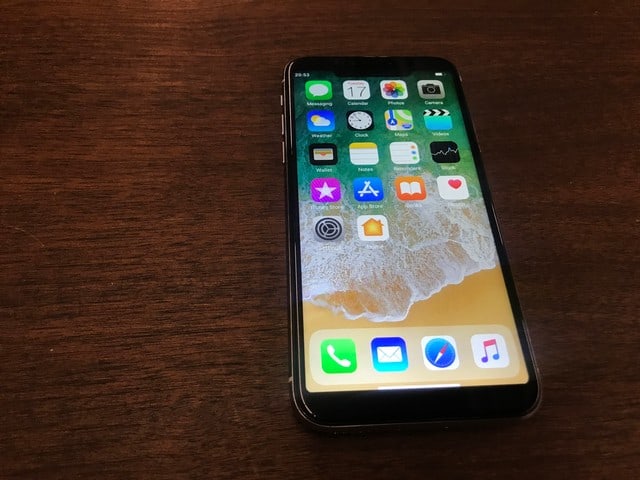Now that rival smartphone makers have had some time to follow in Apple’s footsteps, you don’t have to spend $1,000 on an iPhone X to enjoy features like facial recognition and an edge-to-edge screen. For instance, this handset looks almost exactly like Apple’s latest flagship, and yet it costs just $100.
But don’t be fooled by its pretty face. This unashamed iPhone X clone is as ugly as sin under the surface, and its poor excuse for security is even scarier.
Asus, Huawei, LG, Nokia, and others now offer iPhone X lookalikes. The difference between those and this $100 handset reviewed by Motherboard is that they don’t pretend to be Apple devices. They might have edge-to-edge screens with notches, but their designs differ, and they use different names.
This device uses the iPhone X name, comes in an iPhone X box, and even runs software that looks just like iOS. Sadly, the user experience is horrible.
’Designed by Apple in California’
There’s no doubt this is a convincing phone. “In the back of my mind, I thought that maybe we’d just somehow gotten an insane deal on a real iPhone X,” reads the review. “What was in the box was far more interesting.”
The device has the same form factor as an iPhone X, and most of the same buttons and detailing. It boasts a working Lightning connector, and what its software claims is Face ID. It has an Apple logo on its back, and displays an Apple logo when you boot it up.
The device even runs what looks like iOS. At first glance, you wouldn’t be able to tell the difference. Almost all of Apple’s apps and services have been recreated, including Siri, Camera, Calculator, and the App Store.
“The settings menu looks close-to-identical and has many of the same settings you’d find on an iPhone,” the review continues. “I don’t use the default Mail app on my own iPhone, but the setup process and functionality seem from an end-user point-of-view as basically the same as the real thing.”
The most impressive bit? Even the handset’s IMEI number — the unique serial number assigned to every device with a cellular connection — corresponds to an iPhone X.
The ugly truth
You don’t have to use the device for long to realize this isn’t a real iPhone X running a genuine version of iOS, however.
It’s actually powered by Android, which has been completely redesigned so that it’s barely recognizable as a Google operating system. But plenty of things give it away. The software feels “sluggish and underpowered,” and many apps don’t work as you’d expect.
Siri obviously doesn’t work properly, and when the apparent App Store crashes, an error explains that the “Google Play Store” has malfunctioned. When you need to type something, you get Android’s keyboard instead of iOS’.
The handset’s notch isn’t a real notch, either; it’s just a black bar recreated in the software. And while Face ID is said to be there, and offers the same setup process as a real iPhone X, it doesn’t actually attempt to recognize your face — it just lets anyone in.
A security nightmare
The security concerns don’t stop at fake Face ID.
Motherboard gave the phone to Chris Evans, a researcher with Trail of Bits, who compiled a security report. Evans confirmed the handset runs Android, “with a patchwork of code taken from several different sources.”
Not all of those sources are good ones. Evans also discovered the phone is “loaded with backdoors and malicious apps,” while security features like permissions, regulation, or sandboxing are “almost non-existent.”
If that’s not enough to put you off, the phone also logs your iCloud username and password after you’ve signed in and makes them available to any app or service you use on your device — including all the malicious ones.
A design disaster below the surface
Pull apart this device and the efforts to copy Apple disappear completely. Unlike a real iPhone X, which iFixit describes as “the pinnacle of electronic engineering,” this thing is thrown together with little effort.
The handset’s logic board “looks like a plug-and-play from something else,” the review describes, and components like the Haptic Engine, which you would usually find inside an Apple device, are missing. None of the chips are the same, either.
What’s more, almost everything inside the phone is held together by metal rivets, which makes replacing any of its components near impossible. “Replacing the battery would mean destroying the phone entirely.”
’The most interesting piece of technology’
Obviously you should steer well clear of $100 iPhone X clones sold in China. Not only will you be sorely disappointed with what you get, but there’s a good chance someone somewhere is watching everything you do with it.
Nevertheless, it’s a fascinating device that goes to great lengths to imitate the iPhone X in some areas, and takes a completely different route in others. “It is by far the most interesting piece of technology I’ve come across this year,” Motherboard concludes.
Check out the full review, which is just as interesting as the device itself, to find out more.


